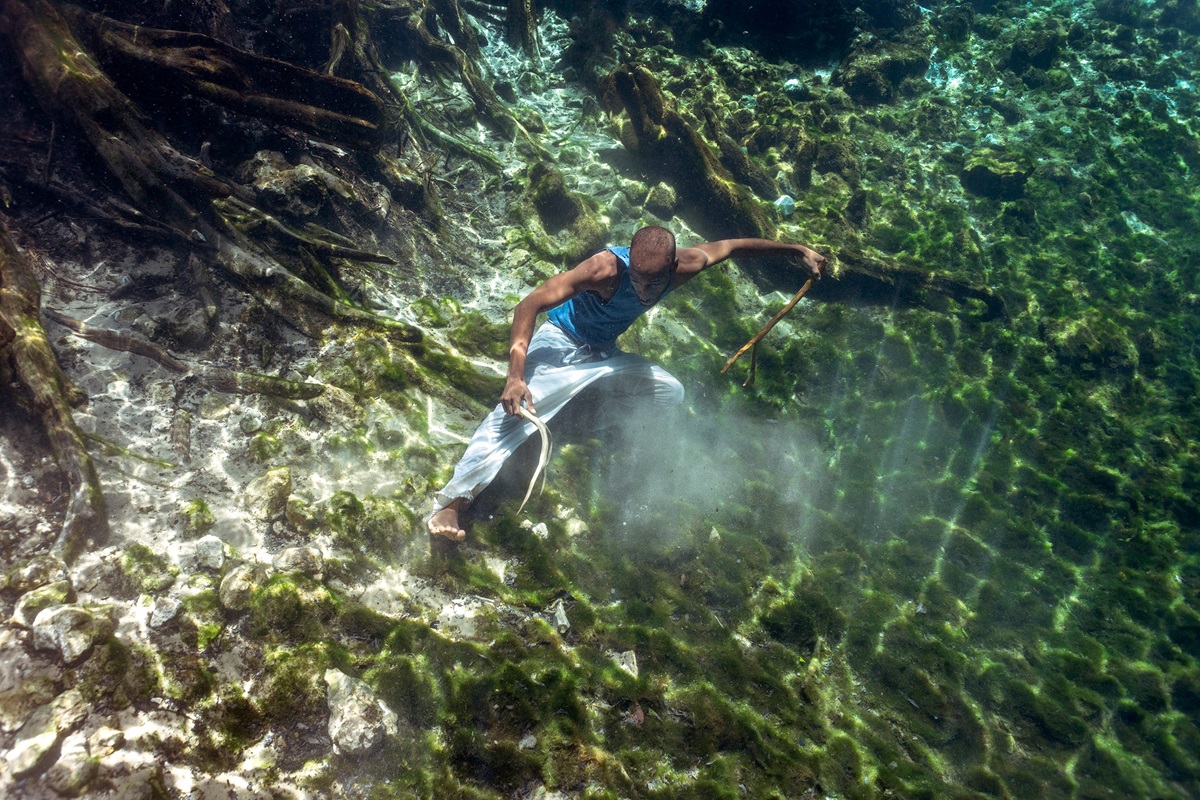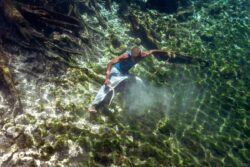The Art of Language
The Art of Language
Published: November 30, 2023
Last Updated: February 29, 2024

Capitol Park Museum
Michel Varisco, Plowing the Sea, 2020. Thermal dye sub on aluminum.
Guest curator Jonathan Mayers, a visual artist and cultural activist, collaborated with artists and writers who have been distanced from their cultures as a result of Americanization or physical location as well as others who have embraced the cultures of the region. As Alex Johnson laments in her poem “Mo Kréyol (I am Creole),” “My grandmother never taught me to speak our native language / She told me children didn’t need to know the language of their elders.” This expression of Creole identity appears alongside Chase Julien’s The Flowers Were Clipped but the Roots Remain, which visually suggests both the damage to culture and the strength of its foundation. Mayers first experimented with these juxtapositions in a 2018 exhibition, Mythologies Louisianaises, at the Arthur Roger Gallery in New Orleans. Mayers has expanded his scope, adding Tunica into the conversation—thanks to the Pierite family and the Kuhpani Yoyani Luhchi Yoroni (KYLY) Tunica Language Project. Dr. Darius A. Spieth, a professor of art history at Louisiana State University, writes, “This expanding exhibition concept brings together the best artists and writers from the southern part of the state of Louisiana who are inspired by the power of their imagination, and who seek to tell, through their art or their poetry, narratives of this land that they cherish.”
Drawing on themes that include environmental devastation and social justice, these artists and writers elucidate the relationship between Louisiana’s heritage languages and connections to the land, especially in a time of land loss. Ron Bechet’s handcrafted triptych, Still Rising, features portraiture of Sharon Lavigne, a St. James native and 2021 Goldman Prize recipient who, along with Rise St. James, had success in halting the construction of a plastics manufacturing plant in St. James Parish. Sheriden Booker’s accompanying text, written in English and Kouri-Vini, “Sir Dolo: The Story of How Crawfish Drove Bèt Piyant Out of Town,” is dedicated to Lavigne. This collaboration and that between Emily Margaret Randall and Adrien Guillory-Chatman, Dolo ki répozé (Quiescent Waters), among others, prompts Dr. Robin White to find that this exhibition “invites us to make a clean sweep of received ideas and to change our perception of Louisiana.”
Among the artists represented are Charles Barbier, Dale Pierrottie, Douglas Bourgeois, Nyssa Juneau, Demond Matsuo, Dan Charbonnet, Francis X. Pavy, Pippin Frisbie-Calder, Michel Varisco, and Simon Alleman; among the writers are Katarina Boudreaux, David Cheramie, Martha Serpas, Beverly Matherne, and Henry Johnson. Language activist Clif St. Laurent provides Kouri-Vini translations to the majority of featured texts. An educational map of Lalwizyàn (Louisiana) created by Dr. Christophe Landry, on loan by Chinbo, Inc., provides visitors with location names around the state in Kouri-Vini. As the exhibition’s creative partners “réklamé mañè-layé péyisaj maré yê ensemb” (reclaim the ways in which the landscape binds them), they invite visitors to engage in this homage to the state’s languages and folklore.
The exhibition will be accompanied by texts by Robin White, professor of English at Nicholls State University, and Darius A. Spieth, professor of art history at Louisiana State University, who also contributed the preface and the introductory essay, respectively, to the catalog that will accompany Mitoloji Latannyèr.
Mitoloji Latannyèr/Mythologies Louisianaises will be on display through December 2024 at Capitol Park Museum, 440 N. Fourth Street, Baton Rouge. For more information, visit louisianastatemuseum.org.
